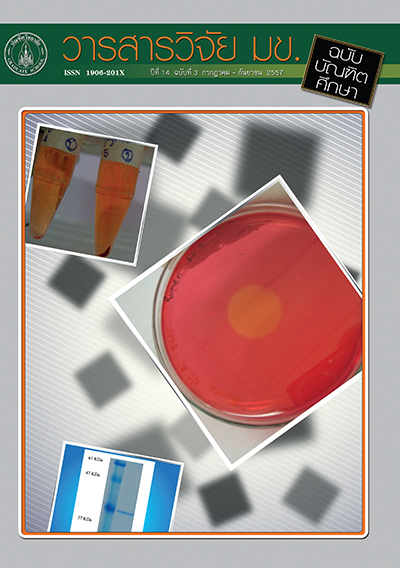การบำบัดน้ำเสียของโรงงานข้าวแคบ ด้วยการลดความเป็นกรดโดย ใช้หินปูนและการบำบัดแบบธรรมชาติ ของโครงการศึกษาวิจัยและ พัฒนาสิ่งแวดล้อมแหลมผักเบี้ยอันเนื่องมาจากพระราชดำริ๖๗
Keywords:
Khaew kaeb factory(โรงงานข้าวแคบ), Deacidification(การลดความเป็นกรด), Natural treatment system(ระบบบำบัดแบบธรรมชาติ)Abstract
ข้าวแคบเป็นผลิตภัณฑ์ที่ได้จากการหมักน้ำแป้ง จากข้าวกับเกลือ น้ำทิ้งปริมาณมาก ประกอบกับ มีสารอินทรีย์ (ซีโอดี = 1260 มก./ลิตร) และความเป็นกรดสูง (pH = 3.3) ถ้าถูกปล่อยออกสู่แหล่งน้ำจะ ทำให้เกิดปัญหาสิ่งแวดล้อมทางน้ำได้ งานวิจัยนี้จึงมีวัตถุประสงค์เพื่อศึกษาวิธีที่ง่ายต่อการบำบัดน้ำเสียดังกล่าว ด้วยกระบวนการลดความเป็นกรดโดยใช้หินปูน และพบว่าการแช่หินปูน 60 กิโลกรัมในน้ำเสีย 60 ลิตร ใน ระยะเวลา 7 วัน สามารถเพิ่มค่าพีเอชจาก 3.3 เป็น 7.0 จากนั้นน้ำน้ำเสียที่ผ่านการลดความเป็นกรดมาศึกษา โดยการทดลองแบบแบตซ์และการทดลองแบบไหลต่อเนื่อง จากการทดลองแบบแบตซ์ พบว่าถ่านกะลา มะพร้าวสามารถบำบัดสีได้ 64.3% บำบัดความขุ่นได้ 94.9% และบำบัดซีโอดีได้ 42.8% และรูปแบบการดูด ซับสอดคล้องกับไอโซเทอร์มการดูดซับของแลงเมียร์และฟรุนดิซ การทดลองแบบไหลต่อเนื่องที่มีการบรรจุ ชั้นกรอง ซึ่งชั้นบนสุดเป็นถ่านกะลามะพร้าวผสมกับดินนาในอัตราส่วน 1:10 พบว่าการบำบัดน้ำเสีย ที่เลียนแบบระบบหญ้ากรองน้ำเสียมีประสิทธิภาพสูงกว่าพื้นที่ชุ่มน้ำเทียม ดังนั้นระบบหญ้ากรองน้ำเสีย จึงถูกน้ำมาทดลองโดยใช้เทคนิคการกรองในหน่วยทดลองขนาดเล็กและปลูกกกกลมและธูปฤาษี ผลการ ทดลองพบว่าหน่วยทดลองที่ปลูกธูปฤาษีให้ประสิทธิภาพการบำบัดความขุ่น และซีโอดีสูงที่สุด ที่ร้อยละ 79.8 และ 92.8 ตามลำดับ
KhaewKaeb is produced from thefermention of starch water from rice with salt. The aquatic environmental problem could be occurred fromlargeamount of the effluent with high organic content (COD=1260mg/L) and acidity (pH=3.3) was discharged to water resource. This research aims to study the simple way treatment of this effluent. Therefore, deacidification by using limestone was carried out and found that soaking limestone 60 kg to 60 L of wastewater for 7 days could increase pH from 3.3 to 7.0.Then, the deacidified wastewater was studied by batch experiment and continuous flow experiment. From batch experiment,it was found that coconut shell charcoal had treatability of color at 64.3%, turbidity at 94.9% and COD at 42.8% and the adsorption model was conformed to both of Langmuir and Freundich isotherm. From continuous flow experiment that packing filter layer and the top layer of the mixture of coconut shell charcoal and soil in ratio of 1:10, it was found that wastewater treatment similar to the grass filtration gave the higher efficiency than constructed wetland. Therefore, the grass filtration system was tested by the filtrated lysimeter technique and growing Cyperus Corymbosus Rottb. and Typha angustifolia Linn. The results showed that the experimental unit which growing Typha angustifolia Linn in mixed of coconut shell charcoal gave the highest removal efficiency percentage of turbidity and COD at 79.8 and 92.8 respectively.



